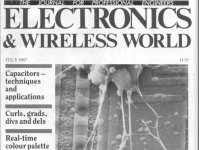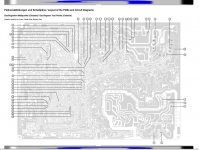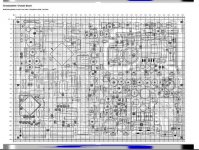Yeah, double ground plain shielded, gold plated, no solder mask, circuit board drawn on a million dollar computer, in 1984. Now, Steve can do it in his backyard with his Dell. ;-)
In 1984 I was doing more complicated and better looking boards than that on an $800 PC clone.
Before that I did camera-ready artwork by hand on mylar using rub-off transfers, tape and Rapidograph pens.
So don't talk to me about circuit boards, John.
An externally hosted image should be here but it was not working when we last tested it.
se
Eh? What sleevin's that?
se
From the RCA jacks to the board.
From the RCA jacks to the board.
That ain't sleevin'.
It's the wire's insulation.
It's an ultra fine strand silver plated copper wire with a relatively thick clear silicone insulation.
Here's a bit better photo of it in a current model Coda preamp:

se
Your traces are too far apart.
If you're talking about the Coda preamp, they're not my traces. If you're talking about my preamp, the only traces seen in the photograph are for the DC control lines for the relays.
se
Why silicone?
It was a nice wire. EXTREMELY flexible (a combination of the ultra fine stranding and the silicone).
se
For detailed pictures of the SCP-1 and its aluminum box, go to: Vendetta Research and on our website look at Japanese pictures linked the bottom of the page. This will give you a feeling of what a REAL circuit layout and box design should look like. We are still happy with it.
John, how does the RIAA network not count as in the signal path? "No capacitors in the signal path".
Soundminded, aluminum and other conducting materials do not shield against STATIC magnetic field (= DC). That's usually not an issue in amplifiers. But it does shield against 50/60Hz alternating magnetic field and shield effect can be easily calculated from well known formula, containing conductivity, thickness and frequency, with permeability = 1. Is it so difficult to understand?
Yes it is extremely difficult to understand and accept. Even in a steel case which is far more efficient at shielding 50 and 60 hz magentic fields than copper or aluminum, as I pointed out earlier the losses from all sources is only 8% and eddy current losses in the core and the case are the least of it. Let's see your calculations with real numbers and how you apply the formulae in Maxwell's laws to predict eddy current losses or any other magnetic field losses in copper or aluminum.
Unless you have a balanced input or a transformer, this will do you little good. Why?
Ugh, that is what I suggested.
If you're talking about the Coda preamp, they're not my traces. If you're talking about my preamp, the only traces seen in the photograph are for the DC control lines for the relays.
se
I remember your layouts.
It always interested me the way you
used all right-angle turns on the traces.
( I always strived for as gradual of curve
as possible )
( In order not to jerk the electron flow
Yes, this bothers me too. They ARE in the signal path but somehow they are never mentioned to be IN. EVERYBODY, not only John uses this nomenclature. Even the scientist that made me think to close my MPP thread.
IMHO, you're very generous with the "scientist" label; more commonly such people who excellently apply text book material are at best very good engineers. They follow the edge whereas real scientists define it.
I remember your layouts.
It always interested me the way you
used all right-angle turns on the traces.
( I always strived for as gradual of curve
as possible )
( In order not to jerk the electron flow)
I'm a sadist. I love watching their little heads jerk back and forth.
And I don't always use right angles. It really depends on my mood.
What I REALLY love are those beautiful, fluid, hand drawn boards that are exemplified by Japanese made electronics from the 60's and 70's. Those really gave meaning to the term circuit board "artwork." They were so... "organic."
Here's an example. Not the best I've seen, but it gets the idea across.
An externally hosted image should be here but it was not working when we last tested it.
Someday I'm going to get another drafting table, some mylar and a set of Rapidographs.
se
- Status
- Not open for further replies.
- Home
- Member Areas
- The Lounge
- John Curl's Blowtorch preamplifier part II


